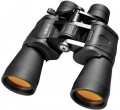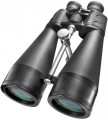Zoom adjustment
The ability to change the magnification of the optics (see above). Models with this function are more versatile than those with a fixed multiplicity. Depending on the situation, they can be used to examine both a large scene (at low magnifications and large viewing angles) and individual small details (vice versa). And if the object is lost from the field of view, you can reduce the magnification and easily find it. On the other hand, the ability to adjust significantly increases the price and reduces the reliability of the entire device.
Field of view 1 km away
The diameter of the area visible through binoculars / monoculars from a distance of 1 km — in other words, the largest distance between two points at which they can be seen simultaneously from this distance. It is also called "linear field of view". Along with the angular field of view (see below), this parameter characterizes the space covered by the optics; at the same time, it describes the capabilities of a particular model more clearly than data on viewing angles. Models with magnification adjustment (see above) usually indicate the maximum field of view — at the lowest magnification and
the widest angle of view. This information is often supplemented by data on the minimum value.
Min. focus distance
The smallest distance to the observed object, at which it will be clearly visible through binoculars / monoculars. All such optical instruments were initially created for observing remote objects, therefore, not all of them are able to work at short distances. When choosing a model for this parameter, one should proceed from the expected observation conditions: ideally, the minimum focus distance should not be greater than the smallest possible distance to the observed object.
Twilight factor
A complex indicator that describes the quality of binoculars / monoculars at dusk — when the illumination is weaker than during the day, but not yet as dim as in the deep evening or at night. It is primarily about the ability to see small details through the device. The need to use this parameter is due to the fact that twilight is a special condition. In daylight, the visibility of small details through binoculars is determined primarily by the magnification of the optics, and in night light, by the diameter of the lens (see below); at dusk, both of these indicators affect the quality. This feature takes into account the twilight factor. Its specific value is calculated as the square root of the product of the multiplicity and the diameter of the lens. For example, for 8x40 binoculars, the twilight factor will be the root of 8x40=320, that is, approximately 17.8. In models with power adjustment (see above), the minimum twilight factor is usually indicated at the lowest magnification, but data is often given for the maximum. The lowest value of this parameter for normal visibility at dusk is considered to be 17. At the same time, it is worth noting that the twilight factor does not take into account the actual light transmission of the system — and it strongly depends on the quality of lenses and prisms, the use of antireflection coatings, etc. Therefore, the actual image quality at dusk for two models with the same twilight factor may differ markedly.
Relative brightness
One of the parameters describing the quality of visibility through an optical device in low light conditions. Relative brightness is denoted as the diameter of the exit pupil (see below) squared; the higher this number, the more light the binoculars/monoculars let through. At the same time, this indicator does not take into account the quality of lenses, prisms and coatings used in the design. Therefore, comparing the two models in terms of relative brightness is only possible approximately, since even if the values are equal, the actual image quality may differ markedly.
Diopter adjustment
The presence in binoculars / monoculars of the function of diopter correction. This feature will be very useful if you wear glasses due to nearsightedness or farsightedness. By setting the required number of "plus" or "minus" diopters on the adjustment scale, you can look into the eyepiece with the naked eye and see a clear picture — the optics of the device will provide the necessary correction. It is much more convenient than watching through glasses. However one should not forget that the correction range (see below) is usually small, and in case of serious visual impairments, the capabilities of the binoculars may not be enough; but such situations are still quite rare. In binoculars (see "Type"), this adjustment is usually carried out for each eyepiece separately, because The diopters required for each eye may also be different. Features of the correction control depend on the type of focus (see below). With separate focus, each eyepiece is adjusted with its own regulator, with the central one of the halves (usually the left) is regulated using a common focus handwheel, and the second with a separate knob on the eyepiece (although here there are separate regulators on both eyepieces).
Lens diameter
The lens diameter is the front lens of the binocular/monocular. This parameter is also called "aperture". Designate it in millimetres. Aperture is one of the most important characteristics of an optical device: it describes the amount of light that the device is able to "capture" into the lens, and largely determines the image quality in low light. Therefore, the second number in the traditional marking of binoculars / monoculars is precisely the diameter of the lens — for example, 8x40 mm corresponds to 8x binoculars with an aperture of 40 mm. In addition, with a large lens it is easier to provide a wide field of view without sacrificing magnification. In general, the larger the aperture, the more advanced the optical device is considered. On the other hand, the increase in lenses has a corresponding effect on the weight and dimensions of the entire structure. And you should not forget about the influence of individual components of the system (for example, prisms) on the overall image quality.
Exit pupil diameter
The diameter of the exit pupil created by the optical system of a binocular/monocular. The exit pupil is called the projection of the front lens of the lens, built by the optics in the region of the eyepiece; this image can be observed in the form of a characteristic light circle, if you look into the eyepiece not close, but from a distance of 30 – 40 cm. The diameter of this circle is measured according to a special formula — dividing the diameter of the lens by the multiplicity (see above). For example, an 8x40 model would have a pupil diameter of 40/8=5mm. This indicator determines the overall aperture of the device and, accordingly, the image quality in low light: the larger the pupil diameter, the brighter the “picture” will be (of course, with the same quality of prisms and glasses, because they also affect the brightness). In addition, it is believed that the diameter of the exit pupil should be no less than that of the pupil of the human eye — and the size of the latter can vary. So, in daylight, the pupil in the eye has a size of 2-3 mm, and in the dark — 7-8 mm in adolescents and adults, and about 5 mm in the elderly. This point should be taken into account when choosing a model for specific conditions: after all, fast models are expensive, and it hardly makes sense to overpay for a large pupil if you need binoculars exclusively for daytime use.
Eye relief
The offset is the distance between the eyepiece lens and the exit pupil of an optical instrument (see "Exit Pupil Diameter"). Optimum image quality is achieved when the exit pupil is projected directly into the observer's eye; so from a practical point of view, offset is the distance from the eye to the eyepiece lens that provides the best visibility and does not darken the edges (vignetting). A large offset is especially important if the binoculars / monoculars are planned to be used simultaneously with glasses — because in such cases it is not possible to bring the eyepiece close to the eye.

